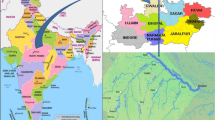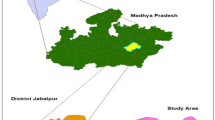Abstract
The present study has applied artificial neural network (ANN) and multiple linear regression (MLR) techniques to predict the fitness of groundwater quality for drinking from Shivganga River basin, located on the eastern slopes of the Western Ghat region of India. In view of this, thirty-four (34) representative groundwater samples have been collected and analyzed for major cations and anions during pre- and post-monsoon seasons of 2015. The physicochemical parameters such as pH, EC, TDS, TH, Ca, Mg, Na, K, Cl, HCO3, SO4, NO3 and PO4 were considered for computing water quality index (WQI). Analytical results confirmed that all the parameters are within acceptable range; however, EC, TDS, TH, Ca and Mg are exceeding the desirable limit of the WHO drinking standards. The groundwater suitability for drinking was ascertained by WQI method. The WQI value ranges from 25.75 to 129.07 and from 37.54 to 91.38 in pre- and post-monsoon seasons, respectively. Only one sample (DW5) shows 129.07 WQI value indicating poor quality for drinking due to input of domestic and agricultural waste. In the view of generating consistent and precise model for prediction of WQI-based groundwater quality, a Levenberg–Marquardt three-layer back propagation algorithm was used in ANN architecture. Further, MLR model is used to check the efficiency of ANN prediction. The results corroborated that predictions of ANN model are satisfactory and confirms consistently acceptable performance for both the seasons. The proposed ANN model may be useful in similar studies of groundwater quality prediction for drinking purpose.






Similar content being viewed by others
References
Adimalla N (2018) Groundwater quality for drinking and irrigation purposes and potential health risks assessment: a case study from semi-arid region of South India. Exposure Health. https://doi.org/10.1007/s12403-018-0288-8
Al-Aboodi AH, Abbas SA, Ibrahim HT (2018) Effect of Hartha and Najibia power plants on water quality indices of Shatt Al-Arab River, south of Iraq. Appl Water Sci 8:64. https://doi.org/10.1007/s13201-018-0703-0
APHA, Federation and WE and American Public Health Association (2005) Standard methods for the examination of water and wastewater 2005. American Public Health Association (APHA), Washington
Banerjee P, Ghose MK, Pradhan R (2018) AHP-based spatial analysis of water quality impact assessment due to change in vehicular traffic caused by highway broadening in Sikkim Himalaya. Appl Water Sci 8:72. https://doi.org/10.1007/s13201-018-0699-5
Barzegar R, Asghari Moghaddam A (2016) Combining the advantages of neural networks using the concept of committee machine in the groundwater salinity prediction. Model Earth Syst Environ 2:26. https://doi.org/10.1007/s40808-015-0072-8
Beane JE, Turner CA, Hooper PR et al (1986) Stratigraphy, composition and form of the Deccan Basalts, Western Ghats, India. Bull Volcanol 48:61–83. https://doi.org/10.1007/BF01073513
Beaumont C, Makridakis S, Wheelwright SC, McGee VE (1984) Forecasting: methods and applications. J Oper Res Soc 35:79. https://doi.org/10.2307/2581936
Bhargava D (1983) Use of water quality index for river classification and zoning of Ganga river. Environ Pollut Ser B Chem Phys 6:51–67. https://doi.org/10.1016/0143-148X(83)90029-0
Brown A, Matlock MD (2011) A review of water scarcity indices and methodologies. University of Arkansas. The sustainability consortium, Fayetteville, p 21
Brown RM, McClelland NI, Deininger RA, Tozer RG (1970) A water quality index-do we dare? water sewage. Works, October, pp 339–343
Darbandi S, Pourhosseini FA (2018) River flow simulation using a multilayer perceptron-firefly algorithm model. Appl Water Sci 8:85. https://doi.org/10.1007/s13201-018-0713-y
Dzwairo B, Hoko Z, Love D, Guzha E (2006) Assessment of the impacts of pit latrines on groundwater quality in rural areas: a case study from Marondera district. Zimbabwe Phys Chem Earth 31:779–788. https://doi.org/10.1016/j.pce.2006.08.031
Emamgholizadeh S, Kashi H, Marofpoor I, Zalaghi E (2014) Prediction of water quality parameters of Karoon River (Iran) by artificial intelligence-based models. Int J Environ Sci Technol 11(3):645–656
Gaikwad S, Gaikwad S, Meshram D, Wagh V, Kandekar A, Kadam A (2019) Geochemical mobility of ions in groundwater from the tropical western coast of Maharashtra, India: implication to groundwater quality. Environ Dev Sustain 1–34
Gazzaz NM, Yusoff MK, Aris AZ et al (2012) Artificial neural network modeling of the water quality index for Kinta River (Malaysia) using water quality variables as predictors. Mar Pollut Bull 64:2409–2420. https://doi.org/10.1016/j.marpolbul.2012.08.005
Hassan M, Zaffar H, Mehmood I, Khitab A (2018) Development of streamflow prediction models for a weir using ANN and step-wise regression. Model Earth Syst Environ 4(3):1021–1028
Horton RK (1965) An index number system for rating water quality. J Water Pollut Control Fed 37(3):300–306
Huang S-C, Huang Y-F (1990) Learning algorithms for perceptions using back-propagation with selective updates. IEEE Control Syst Mag. https://doi.org/10.1109/37.55125
Javdanian H (2017) Assessment of shear stiffness ratio of cohesionless soils using neural modeling. Model Earth Syst Environ 3(3):1045–1053
Jeong CH (2001) Effect of land use and urbanization on hydrochemistry and contamination of groundwater from Taejon area. Korea J Hydrol 253:194–210. https://doi.org/10.1016/S0022-1694(01)00481-4
Kadam AK, Jaweed TH, Umrikar BN et al (2017) Morphometric prioritization of semi-arid watershed for plant growth potential using GIS technique. Model Earth Syst Environ 3:1663–1673. https://doi.org/10.1007/s40808-017-0386-9
Kadam A, Karnewar AS, Umrikar B, Sankhua RN (2018) Hydrological response-based watershed prioritization in semiarid, basaltic region of western India using frequency ratio, fuzzy logic and AHP method. Environ Dev Sustain
Kaurish FW, Younos T (2007) Developing a standardized water quality index for evaluating surface water quality. J Am Water Resour Assoc 43:533–545. https://doi.org/10.1111/j.1752-1688.2007.00042.x
Khalil B, Ouarda TBMJ, St-Hilaire A (2011) Estimation of water quality characteristics at ungauged sites using artificial neural networks and canonical correlation analysis. J Hydrol 405:277–287. https://doi.org/10.1016/j.jhydrol.2011.05.024
Kiraz A, Canpolat O, Erkan EF, Özer Ç (2018) Artificial neural networks modeling for the prediction of Pb (II) adsorption. Int J Environ Sci Technol 1–8
Logeshkumaran A, Magesh NS, Godson PS, Chandrasekar N (2014) Hydro-geochemistry and application of water quality index (WQI) for groundwater quality assessment, Anna Nagar, part of Chennai City, Tamil Nadu, India. https://doi.org/10.1007/s13201-014-0196-4
Malinova T, Guo ZX (2004) Artificial neural network modelling of hydrogen storage properties of Mg-based alloys. Mater Sci Eng A 365:219–227. https://doi.org/10.1016/j.msea.2003.09.031
Moon SK, Woo NC, Lee KS (2004) Statistical analysis of hydrographs and water-table fluctuation to estimate groundwater recharge. J Hydrol 292(1–4):198–209
Mladenović-Ranisavljević II, Žerajić SA (2017) Comparison of different models of water quality index in the assessment of surface water quality. Int J Environ Sci Technol. https://doi.org/10.1007/s13762-017-1426-8
Mukate S, Panaskar D, Wagh V et al (2017) Impact of anthropogenic inputs on water quality in Chincholi industrial area of Solapur, Maharashtra, India. Groundw Sustain Dev. https://doi.org/10.1016/j.gsd.2017.11.001
Panaskar DB, Wagh VM, Muley AA et al (2016) Evaluating groundwater suitability for the domestic, irrigation, and industrial purposes in Nanded Tehsil, Maharashtra, India, using GIS and statistics. Arab J Geosci. https://doi.org/10.1007/s12517-016-2641-1
Pawar NJ, Pawar JB, Kumar S, Supekar A (2008) Geochemical eccentricity of ground water allied to weathering of basalts from the Deccan Volcanic Province, India: insinuation on CO2 consumption. Aquat Geochem 14(1):41–71
Pesce SF, Wunderlin DA (2000) Use of Water Quality Indices To Verify the  Rdoba City (Argentina) on Suquõâ a Impact of Co. Science 80: 34
Sahu P, Sikdar PK (2008) Hydrochemical framework of the aquifer in and around East Kolkata Wetlands, West Bengal, India. Environ Geol 55(4):823–835
Sahoo S, Jha MK (2013) Groundwater-level prediction using multiple linear regression and artificial neural network techniques: a comparative assessment. Hydrogeol J 21(8):1865–1887
Sakizadeh M (2016) Artificial intelligence for the prediction of water quality index in groundwater systems. Model Earth Syst Environ 2(1):8
Salari M, Salami Shahid E, Afzali SH, Ehteshami M, Conti GO, Derakhshan Z, Sheibani SN (2018) Quality assessment and artificial neural networks modeling for characterization of chemical and physical parameters of potable water. Food Chem Toxicol 118:212–219. https://doi.org/10.1016/j.fct.2018.04.036
Şener Ş, Şener E, Davraz A (2017) Evaluation of water quality using water quality index (WQI) method and GIS in Aksu River (SW-Turkey). Sci Total Environ 584–585:131–144. https://doi.org/10.1016/j.scitotenv.2017.01.102
Sharma N, Zakaullah M, Tiwari H, Kumar D (2015) Runoff and sediment yield modeling using ANN and support vector machines: a case study from Nepal watershed. Model Earth Syst Environ 1(3):23
Shooshtarian MR, Dehghani M, Margherita F, Gea OC, Mortezazadeh S (2018) Land use change and conversion effects on ground water quality trends: an integration of land change modeler in GIS and a new ground water quality index developed by fuzzy multi-criteria group decision-making models. Food Chem Toxicol 114:204–214
Sihag P (2018) Prediction of unsaturated hydraulic conductivity using fuzzy logic and artificial neural network. Model Earth Syst Environ 4(1):189–198
Varol S, Davraz A (2014) Evaluation of the groundwater quality with WQI (water quality index) and multivariate analysis: a case study of the Tefenni plain (Burdur/Turkey). Environ Earth Sci 73:1725–1744. https://doi.org/10.1007/s12665-014-3531-z
Vasant W, Dipak P, Aniket M, Ranjitsinh P, Shrikant M, Nitin D, Manesh A, Abhay V (2016) GIS and statistical approach to assess the groundwater quality of Nanded Tehsil, (MS) India. In: Proceedings of first international conference on information and communication technology for intelligent systems, vol 1, pp 409–417. Springer, Cham
Wagh VM, Panaskar DB, Varade AM et al (2016a) Major ion chemistry and quality assessment of the groundwater resources of Nanded tehsil, a part of southeast Deccan Volcanic Province, Maharashtra, India. Environ Earth Sci. https://doi.org/10.1007/s12665-016-6212-2
Wagh VM, Panaskar DB, Muley AA et al (2016b) Prediction of groundwater suitability for irrigation using artificial neural network model: a case study of Nanded tehsil, Maharashtra, India. Model Earth Syst Environ 2:196. https://doi.org/10.1007/s40808-016-0250-3
Wagh VM, Panaskar DB, Muley AA, Mukate SV (2017a) Groundwater suitability evaluation by CCME WQI model for Kadava River Basin, Nashik, Maharashtra, India. Model Earth Syst Environ 3:557–565. https://doi.org/10.1007/s40808-017-0316-x
Wagh VM, Panaskar DB, Muley AA (2017b) Estimation of nitrate concentration in groundwater of Kadava river basin-Nashik district, Maharashtra, India by using artificial neural network model. Model Earth Syst Environ 3(1):36
Wagh V, Panaskar D, Mukate S, Lolage Y, Muley A (2017c) Groundwater quality evaluation by physicochemical characterization and water quality index for Nanded Tehsil, Maharashtra, India. In: Proceedings of the 7th international conference on biology, environment and chemistry, IPCBEE, vol 98
Wagh VM, Panaskar DB, Mukate SV, Gaikwad SK, Muley AA, Varade AM (2018a) Health risk assessment of heavy metal contamination in groundwater of Kadava River Basin, Nashik, India. Model Earth Syst Environ 4(3):969–980
Wagh V, Panaskar D, Aamalawar M, Lolage Y, Mukate S, Adimalla N (2018b) Hydrochemical characterisation and groundwater suitability for drinking and irrigation uses in semiarid region of Nashik, Maharashtra, India. Hydrospat Anal 2 (1): 43–60, https://doi.org/10.21523/gcj3.18020104
Wagh V, Panaskar D, Muley A et al (2018c) Neural network modelling for nitrate concentration in groundwater of Kadava River basin, Nashik, Maharashtra, India. Groundw Sustain Dev. https://doi.org/10.1016/j.gsd.2017.12.012
Wagh VM, Panaskar DB, Mukate SV, Aamalawar ML, Sahu L, U (2019) Nitrate associated health risks from groundwater of Kadava River Basin Nashik, Maharashtra, India. Hum Ecol Risk Assess 1–19
Wan Abdul Ghani WMH, Abas Kutty A, Mahazar MA et al (2018) Performance of biotic indices in comparison to chemical-based water quality index (WQI) in evaluating the water quality of urban river. Environ Monit Assess. https://doi.org/10.1007/s10661-018-6675-6
WHO (2011) Guidelines for drinking-water quality, 4th edn. http://www.whqlibdoc.who.int/publications/2011/9789241548151_eng.pdf
Yaseen ZM, Fu M, Wang C et al (2018) Application of the hybrid artificial neural network coupled with rolling mechanism and grey model algorithms for streamflow forecasting over multiple time horizons. Water Resour Manag 32:1883–1899. https://doi.org/10.1007/s11269-018-1909-5
Yidana SM, Banoeng-Yakubo B, Akabzaa TM (2010) Analysis of groundwater quality using multivariate and spatial analyses in the Keta basin, Ghana. J Afr Earth Sci 58:220–234. https://doi.org/10.1016/j.jafrearsci.2010.03.003
Yilma M, Kiflie Z, Windsperger A, Gessese N (2018) Application of artificial neural network in water quality index prediction: a case study in Little Akaki River, Addis Ababa, Ethiopia. Model Earth Syst Environ 4:175–187. https://doi.org/10.1007/s40808-018-0437-x
Acknowledgements
The authors extend their sincere thanks to Head, Departments of Geology and Environmental Sciences Savitribai Phule, Pune University, Pune for providing necessary facilities for analysis. In addition, thanks to anonym reviewers for meaningful suggestions to enhance the manuscript quality.
Author information
Authors and Affiliations
Corresponding author
Additional information
Publisher’s Note
Springer Nature remains neutral with regard to jurisdictional claims in published maps and institutional affiliations.
Rights and permissions
About this article
Cite this article
Kadam, A.K., Wagh, V.M., Muley, A.A. et al. Prediction of water quality index using artificial neural network and multiple linear regression modelling approach in Shivganga River basin, India. Model. Earth Syst. Environ. 5, 951–962 (2019). https://doi.org/10.1007/s40808-019-00581-3
Received:
Accepted:
Published:
Issue Date:
DOI: https://doi.org/10.1007/s40808-019-00581-3




